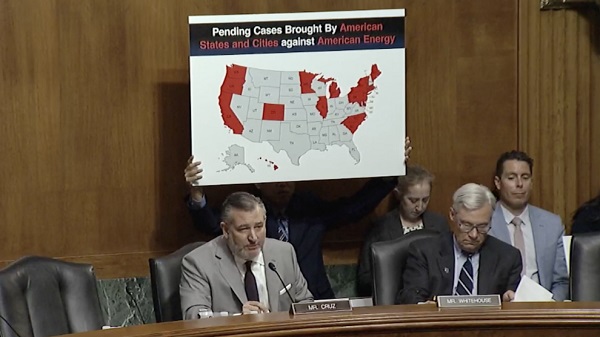Alberta
Hydro-Québec takes partnerships, environmental measures and sharing of wealth to new levels

The Canadian Energy Compendium is an annual Energy Council of Canada initiative which provides opportunity for cross-sectoral collaboration on a topic of shared interest across the Canadian energy sector, produced with the support of Canada’s national energy associations and Energy Council of Canada’s members. The stories contributed to the 2019 edition, Indigenous Energy Across Canada, highlight current conversations celebrating Canada’s dynamic energy sector and encouraging its continuous improvement.
Thanks to Todayville for helping us bring our members’ stories of collaboration and innovation to the public.
Click to read a Foreward from JP Gladu, Chief Development and Relations Officer, Steel River Group; Former President & CEO, Canadian Council for Aboriginal Business

JP Gladu, Chief Development and Relations Officer, Steel
River Group; Former President & CEO, Canadian Council for Aboriginal Business
THE THIRD PHASE OF JAMES BAY DEVELOPMENT: TAKING PARTNERSHIPS, ENVIRONMENTAL MEASURES AND SHARING OF WEALTH TO NEW LEVELS
This article, submitted by Hydro-Québec, will focus on the development of the third phase of the James Bay complex, namely the generating stations namely the Eastmain-1 and Eastmain-1A/Sarcelle/Rupert project. Emphasis will be placed on the development of a new relationship with the Cree that led to an improved project development model.
The Eastmain Complex, the most recent of the James Bay hydroelectric development: Taking partnerships, environmental measures and sharing of wealth to new levels.
When the initial phases of hydropower development in the Baie-James region of Québec was launched in the 1970s, there was no law on the environment, no environmental ministries and no environmental impact assessment process. So consulting affected communities wasn’t on anyone’s agenda and wasn’t yet part of Hydro-Québec’s approach. In the new millennium, with a new phase of development in this region, close-knit partnerships with the Cree Nation have become the cornerstone of project development throughout Québec.
Nadoshtin and Boumhounan agreements paved the way to new developments in Baie-James in the 2000s
The Nadoshtin agreement (2002) between the Crees and Hydro-Québec opened up the possibility of building and operating the Eastmain-1 hydropower project, while the Boumhounan agreement (2002) provided a framework for the Eastmain 1- A/Sarcelle/Rupert project. The key to success for the Eastmain projects was partially diverting the Rupert River’s flow northward.
But Hydro-Québec’s commercial interest in this new project had to be balanced by clear and extensive measures to preserve the surrounding environment and respect host Cree Nation and Cree communities.
In the framework of the Eastmain-1 project, Hydro-Québec made a number of commitments with a view to
- reduce the project’s impacts on the environment
- protect the Cree way of life and encourage partnerships with the Cree communities
- encourage the awarding of contracts to Cree businesses
- promote the training and hiring of Cree workers.
- built local capacity
“…The company wanted to do more than minimize environmental impact; Hydro-Québec wanted community members to see positive gains from the Eastmain developments…”
From the design stage, which was carried out in concert with the Cree, the Eastmain 1-A/Sarcelle/Rupert project incorporated many environmental protection measures, reflecting the Cree traditional knowledge of the community members they consulted. The Cree of Québec were involved in all stages of the project, ensuring they had a voice in how their land would be impacted.

Photo courtesy Hydro-Québec. Yellow sturgeon are raised in a fish hatchery and released into their natural habitat in mid-September, when they have reached a certain maturity. Cree tallymen assist in releasing the fish into the Rupert River in the Baie-James region.
With input from Cree community members, Hydro-Québec devised a combination of dikes and canals to improve water flow, ensuring that the project, which diverts 71% of the river’s flow, flooded only a minimal land area. They also incorporated a substantial ecological in-stream flow and a series of weirs in the river to protect fish habitats, biological diversity, preserve the landscape, and maintain navigation and other activities in the area.
Furthermore, Hydro-Québec signed an unprecedented water management agreement with the Cree to ensure that the modulation of the ecological in-stream flow was managed in a cooperative manner.
Economic spinoffs
In addition to helping preserve the local environment, Hydro-Québec was committed to bringing growth opportunities to the Cree of Québec. The company wanted to do more than minimize environmental impact; Hydro-Québec wanted community members to see positive gains from the Eastmain developments.
Under the Boumhounan Agreement, an extensive participation program built around information and consultation with Cree stakeholders was put in place. It also made funds available for the Cree to finance fisheries, capacity building and traditional activities projects.
When the Eastmain 1A/Rupert diversion project was completed in 2013, the Cree and Hydro-Québec signed the Reappropriation Agreement, giving Cree land users the necessary support to maintain their traditional activities as long as the Rupert River diversion is in operation.
Post-project consultations: ensuring that measures were effective
The COMEX, a joint committee composed of 3 members appointed by the Government Quebec and 2 members appointed by the Cree Nation government, organized consultations with Cree communities to hear their views on the effectiveness of environmental and social mitigation measures put in place for the Eastmain 1A/Rupert diversion project. Approximately 200 members of the Cree Nation from six communities participated in the consultations organized in November 2012.

Photo courtesy Hydro-Québec. Between 2002 and 2005, prior to the impoundment of the Eastmain-1 reservoir, 50 archeologists and Cree workers undertook archeological digs. They discovered 158 sites and their work shows that the Baie-James territory has been occupied by these populations for the last 5,000 years.
The major findings of the COMEX were as follows:
- […]”the Committee is convinced that the Eastmain-1-A and Sarcelle Powerhouses and Rupert Diversion Project will have contributed to greater understanding between all the parties concerned, to greater Cree involvement in the development of the territory, and perhaps to empowering them to achieve their long- term economic and community development goals.”
- “Compared to previous projects carried out in the territory, the Eastmain-1- A/Sarcelle/Rupert project included more adequate and an unprecedented number of mitigation and compensation measures, for both environmental and social impacts. Many of these measures are aimed at helping Cree land users reclaim the territory. A new approach was developed and the Crees have benefited from the partnerships built with the proponent, thereby forging a new relationship.”
- “Hydro-Québec was proactive, exceeding the requirements of the certificate of authorization in an effort to minimize the project’s impacts and ensure greater Cree involvement in environmental and social follow-up activities.”
- “Hydro-Québec went to great lengths to ensure that Aboriginal communities derive benefit from the project.”
A new project development model
The Eastmain Complex – the most recent phase of development in Baie-James – added a potential energy output of 8.7 TWh per year, enough to power more than 500,000 Québec homes. The new relationships that Hydro-Québec and the Cree Nation developed over that period have become models for future energy resource development throughout Québec. With considerable untapped hydropower potential and a strong wind potential in Québec, Hydro-Québec’s new and improved project development model holds great promise for the future of clean energy in northeast North America.

Jacob Irving, President of Energy Council of Canada
The Canadian Energy Compendium is an annual initiative by the Energy Council of Canada to provide an opportunity for cross-sectoral collaboration and discussion on current topics in Canada’s energy sector. The 2020 Canadian Energy Compendium: Innovations in Energy Efficiency is due to be released November 2020.
Click to read comments about this series from Jacob Irving, President of the Energy Council of Canada.
Agriculture
Lacombe meat processor scores $1.2 million dollar provincial tax credit to help expansion

Alberta’s government continues to attract investment and grow the provincial economy.
The province’s inviting and tax-friendly business environment, and abundant agricultural resources, make it one of North America’s best places to do business. In addition, the Agri-Processing Investment Tax Credit helps attract investment that will further diversify Alberta’s agriculture industry.
Beretta Farms is the most recent company to qualify for the tax credit by expanding its existing facility with the potential to significantly increase production capacity. It invested more than $10.9 million in the project that is expected to increase the plant’s processing capacity from 29,583 to 44,688 head of cattle per year. Eleven new employees were hired after the expansion and the company plans to hire ten more. Through the Agri-Processing Investment Tax Credit, Alberta’s government has issued Beretta Farms a tax credit of $1,228,735.
“The Agri-Processing Investment Tax Credit is building on Alberta’s existing competitive advantages for agri-food companies and the primary producers that supply them. This facility expansion will allow Beretta Farms to increase production capacity, which means more Alberta beef across the country, and around the world.”
“This expansion by Beretta Farms is great news for Lacombe and central Alberta. It not only supports local job creation and economic growth but also strengthens Alberta’s global reputation for producing high-quality meat products. I’m proud to see our government supporting agricultural innovation and investment right here in our community.”
The tax credit provides a 12 per cent non-refundable, non-transferable tax credit when businesses invest $10 million or more in a project to build or expand a value-added agri-processing facility in Alberta. The program is open to any food manufacturers and bio processors that add value to commodities like grains or meat or turn agricultural byproducts into new consumer or industrial goods.
Beretta Farms’ facility in Lacombe is a federally registered, European Union-approved harvesting and meat processing facility specializing in the slaughter, processing, packaging and distribution of Canadian and United States cattle and bison meat products to 87 countries worldwide.
“Our recent plant expansion project at our facility in Lacombe has allowed us to increase our processing capacities and add more job opportunities in the central Alberta area. With the support and recognition from the Government of Alberta’s tax credit program, we feel we are in a better position to continue our success and have the confidence to grow our meat brands into the future.”
Alberta’s agri-processing sector is the second-largest manufacturing industry in the province and meat processing plays an important role in the sector, generating millions in annual economic impact and creating thousands of jobs. Alberta continues to be an attractive place for agricultural investment due to its agricultural resources, one of the lowest tax rates in North America, a business-friendly environment and a robust transportation network to connect with international markets.
Quick facts
- Since 2023, there are 16 applicants to the Agri-Processing Investment Tax Credit for projects worth about $1.6 billion total in new investment in Alberta’s agri-processing sector.
- To date, 13 projects have received conditional approval under the program.
- Each applicant must submit progress reports, then apply for a tax credit certificate when the project is complete.
- Beretta Farms has expanded the Lacombe facility by 10,000 square feet to include new warehousing, cooler space and an office building.
- This project has the potential to increase production capacity by 50 per cent, thereby facilitating entry into more European markets.
Related information
Alberta
Alberta Next: Alberta Pension Plan

From Premier Danielle Smith and Alberta.ca/Next
Let’s talk about an Alberta Pension Plan for a minute.
With our young Alberta workforce paying billions more into the CPP each year than our seniors get back in benefits, it’s time to ask whether we stay with the status quo or create our own Alberta Pension Plan that would guarantee as good or better benefits for seniors and lower premiums for workers.
I want to hear your perspective on this idea and please check out the video. Get the facts. Join the conversation.
Visit Alberta.ca/next
-

 Business1 day ago
Business1 day agoCanada’s loyalty to globalism is bleeding our economy dry
-

 Agriculture2 days ago
Agriculture2 days agoCanada’s supply management system is failing consumers
-

 Alberta1 day ago
Alberta1 day agoCOVID mandates protester in Canada released on bail after over 2 years in jail
-

 armed forces24 hours ago
armed forces24 hours agoCanada’s Military Can’t Be Fixed With Cash Alone
-

 Alberta24 hours ago
Alberta24 hours agoAlberta Next: Alberta Pension Plan
-

 International1 day ago
International1 day agoTrump transportation secretary tells governors to remove ‘rainbow crosswalks’
-

 Business1 day ago
Business1 day agoCarney’s spending makes Trudeau look like a cheapskate
-

 Crime1 day ago
Crime1 day agoProject Sleeping Giant: Inside the Chinese Mercantile Machine Linking Beijing’s Underground Banks and the Sinaloa Cartel








